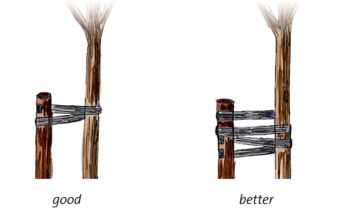There are two anchoring methods:
- Anchoring above the ground, with one or more tree stakes and bands.
- Root-ball anchoring or anchoring below the ground.
There are two anchoring methods:
Place the stakes firmly in the ground, using a ground drill if necessary, with the stake preferably being driven about twenty centimetres into the firm ground under the planting hole. Another rule is that a minimum of a third to a maximum of half of the stake should be below ground. Attach the tree to the stake or stakes using rubber bands. Allow the band to cross over between the tree and tree stake, to prevent friction and therefore damage to the trunk. Check the bands and stakes at least once a year in order to adjust the straps in good time if they are pinching. If a tree is planted with a bare root system, place the tree stakes before planting, in order to avoid damaging the roots.

It is best to use short above-ground tree stakes, which extend a maximum of eighty to a hundred centimetres above ground level. Short tree stakes give trees more freedom to move and they therefore develop stabilisation roots faster. This means the tree will anchor itself better and more quickly. Longer tree stakes, on the other hand, make the tree static and 'lazy', which results in worse anchoring in the short term. Long stakes also have a negative impact on the thickening of the trunk.
Under the point of attachment, the trunk grows widthways more slowly than above the point of attachment, as part of the bending stress is absorbed by the stake. The disadvantage of short stakes is the fact that the trees are more vulnerable to vandalism. Heavier trees in areas with high winds are also more likely to end up crooked, due to the weight of their crown. So short tree stakes aren't necessarily the best alternative in every situation.
The second type of anchoring is root-ball anchoring or anchoring below the ground. The advantage of this is that no stakes are visible, there is no risk of trunk damage and the anchoring never needs to be removed. After a couple of years - once the tree is sufficiently anchored itself - the stakes below the ground rot and become obsolete. N.B. this form of anchoring can only be used if the root ball is sturdy enough and using non-treated stakes.
Method 1: Anchoring with ground anchors
There are various anchoring systems with ground anchors on the market. These anchors are buried deep in the ground alongside the root ball. The band attached to these anchors is stretched over the top of the outside of the root ball. Never stretch bands around the trunk. The type of ground anchor and band to be used depends on the circumference of the planted tree's trunk.
Method 2: Anchoring with stakes
Stakes are driven into the ground around the root ball, with the tops in line with the top of the root ball. Bars are attached to these stakes, in such a way that they grip the top of the outside of the root ball. Another way of anchoring with stakes involves burying the stakes deeper and attaching lashing straps around them. These straps are also stretched over the top of the outside of the root ball.